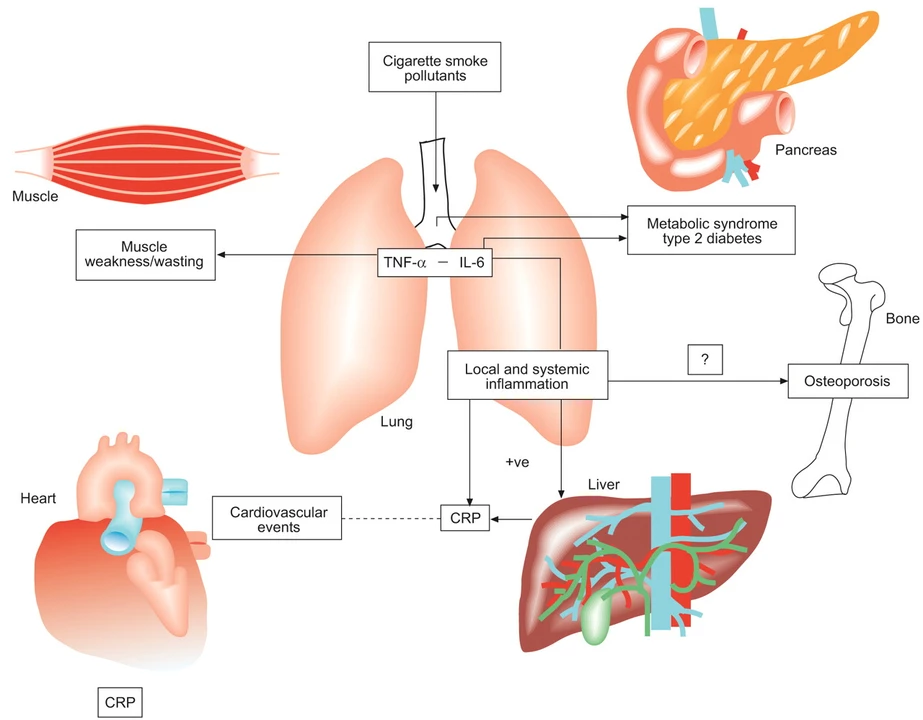Understanding the Connection Between Obstructive Pulmonary Disease and the Cardiovascular System
As someone who has always been fascinated by the human body and its intricate systems, I have come to learn that everything is interconnected. One such connection that has captured my interest is the impact of obstructive pulmonary disease on the cardiovascular system. In this article, I will discuss the various ways in which these two systems are linked and how that relationship can impact our overall health and wellbeing.
The Basics of Obstructive Pulmonary Disease
Before delving into the specifics of how obstructive pulmonary disease affects the cardiovascular system, it's important to understand the basics of this respiratory condition. Obstructive pulmonary disease, or more commonly known as chronic obstructive pulmonary disease (COPD), is a group of progressive lung diseases that include chronic bronchitis and emphysema. This condition is characterized by increasing breathlessness, chronic cough, and excessive mucus production, which can make everyday activities quite challenging.
The primary cause of COPD is long-term exposure to irritants such as tobacco smoke, air pollution, and chemical fumes. This exposure results in inflammation and damage to the airways and the tiny air sacs in the lungs, called alveoli. As the damage progresses, it becomes increasingly difficult for air to flow in and out of the lungs, thus affecting the body's ability to take in oxygen and expel carbon dioxide.
How Obstructive Pulmonary Disease Impacts the Cardiovascular System
Now that we have a better understanding of obstructive pulmonary disease, let's dive into the ways in which it can affect the cardiovascular system. The cardiovascular system encompasses the heart, blood vessels, and the blood itself. Its primary role is to transport oxygen and nutrients to the body's cells and remove waste products. When the lungs are compromised due to obstructive pulmonary disease, this intricate system is also affected. Here are some of the main ways in which the cardiovascular system is impacted:
1. Reduced Oxygen Supply
One of the primary functions of the cardiovascular system is to deliver oxygen-rich blood to the body's cells. However, when the lungs are damaged due to obstructive pulmonary disease, they are unable to effectively take in oxygen and expel carbon dioxide. As a result, the blood carries less oxygen than it should, which can lead to a condition called hypoxemia. This reduced oxygen supply can put strain on the heart and other organs, leading to a variety of health problems.
2. Increased Blood Pressure
When the oxygen levels in the blood are low, the blood vessels in the lungs can constrict, leading to a condition called pulmonary hypertension. This constriction increases the pressure within the pulmonary arteries, making it more difficult for the heart to pump blood through the lungs. Over time, this increased workload can cause the heart to become enlarged and weaken, potentially leading to heart failure.
3. Systemic Inflammation
Chronic inflammation is a hallmark of obstructive pulmonary disease, and it doesn't just affect the lungs. Research has shown that people with COPD often have higher levels of inflammation throughout their body, including in their blood vessels. This systemic inflammation can contribute to the development of atherosclerosis, a condition in which plaque builds up inside the arteries, increasing the risk of heart attack and stroke.
4. Blood Clot Formation
People with obstructive pulmonary disease are at an increased risk of developing blood clots, particularly deep vein thrombosis (DVT) and pulmonary embolism (PE). These clots can block blood flow in the veins, leading to potentially life-threatening complications. The exact reason for this increased risk is not yet fully understood, but it is believed that inflammation, reduced mobility, and changes in blood clotting factors may all play a role.
5. Abnormal Heart Rhythms
Obstructive pulmonary disease can also cause changes in the electrical activity of the heart, leading to abnormal heart rhythms called arrhythmias. These irregular heartbeats can be harmless, but in some cases, they can be life-threatening. People with COPD are particularly at risk for a type of arrhythmia called atrial fibrillation, which can increase the risk of stroke.
Managing the Impact of Obstructive Pulmonary Disease on the Cardiovascular System
While the relationship between obstructive pulmonary disease and the cardiovascular system can be concerning, there are ways to manage these risks and maintain good health. Here are some steps that can be taken:
- Quit smoking and avoid exposure to other lung irritants
- Engage in regular physical activity
- Follow a heart-healthy diet
- Manage stress and maintain a healthy weight
- Take prescribed medications as directed
- Work closely with a healthcare provider to monitor and treat both conditions
By taking these steps, we can not only improve our lung health but also protect our cardiovascular system, ultimately leading to a better quality of life.
Final Thoughts
In conclusion, the impact of obstructive pulmonary disease on the cardiovascular system is complex and multifaceted. By understanding the connection between these two systems, we can better manage our health and reduce the risk of complications. If you or someone you know is living with COPD or another form of obstructive pulmonary disease, I encourage you to share this information and work together with healthcare providers to manage these conditions effectively.







Iván Maceda
May 7, 2023 AT 15:24Vrinda Bali
May 8, 2023 AT 10:51John Rendek
May 9, 2023 AT 04:14Sonia Festa
May 9, 2023 AT 22:28Sara Allen
May 10, 2023 AT 20:50Amina Kmiha
May 11, 2023 AT 20:51Ryan Tanner
May 13, 2023 AT 09:31Jessica Adelle
May 14, 2023 AT 03:53Emily Barfield
May 14, 2023 AT 16:14Sai Ahmed
May 16, 2023 AT 14:50Albert Schueller
May 17, 2023 AT 21:52Ted Carr
May 19, 2023 AT 16:20Rebecca Parkos
May 20, 2023 AT 11:07Bradley Mulliner
May 21, 2023 AT 21:12Rahul hossain
May 23, 2023 AT 07:29Reginald Maarten
May 25, 2023 AT 04:34